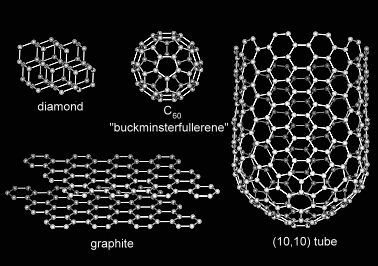|
In fact, what had been discovered was not just a single new molecule but an infinite class of new molecules: the fullerenes. Each fullerene – C60, C70, C84, etc. – possessed the essential characteristic of being a pure carbon cage, each atom bonded to three others as in graphite. Unlike graphite, every fullerene has exactly 12 pentagonal faces with a varying number of hexagonal faces (e.g., buckyball – C60 – has 20).

Figure 1. Various forms of carbon
Some fullerenes, like C60, were spheroidal in shape, and others, like C70, were oblong like a rugby ball. Dr. Richard Smalley recognized in 1990 that, in principle, a tubular fullerene should be possible, capped at each end, for example, by the two hemispheres of C60, connected by a straight segment of tube, with only hexagonal units in its structure. Millie Dresselhaus, upon hearing of this concept, dubbed these imagined objects “buckytubes.”
Carbon Nanotubes
In actuality, however, carbon nanotubes had been discovered 30 years earlier, but had not been fully appreciated at that time. In the late 1950s, Roger Bacon at Union Carbide, found a strange new carbon fibre while studying carbon under conditions near its triple point. He observed straight, hollow tubes of carbon that appeared to consist in graphitic layers of carbon separated by the same spacing as the planar layers of graphite. In the 1970s, Morinobu Endo observed these tubes again, produced by a gas-phase process. Indeed, he even observed some tubes consisting in only a single layer of rolled-up graphite.

Figure 2. Buckytube or carbon nanotube
In 1991, after the discovery and verification of the fullerenes, Sumio Iijima of NEC observed multiwall nanotubes formed in a carbon arc discharge, and two years later, he and Donald Bethune at IBM independently observed single-wall nanotubes – buckytubes. These pure carbon polymers could now be understood in the context of fullerenes, changing the perception of them to molecules, with all that special designation implies. Nanotubes had been fullerenized.
Multiwall Nanotubes
Now, ten years after Iijima’s initial observation, we know a great deal about nanotubes and tubular fullerenes. We know that multiwall nanotubes are invariably produced with a high frequency of structural defects. (In comparison with their larger relations, the 5-20 micron-diameter graphite fibers used in aerospace and sporting goods applications, multiwall nanotubes are quite sound structurally; nevertheless, they frequently contain regions of structural imperfection.) As any material scientist knows, it is the occurrence of defects that inevitably degrade the material properties of a substance, such as strength. The intrinsic properties of a material may be world-beater, but typically the actual properties of the bulk material are only a few percent of what the material would exhibit if it were structurally perfect. For example, a structural defect such as a microcrack in a steel wire, will lead to catastrophic failure at 1-2% of the theoretical breaking strength one would predict based on fundamental chemical principals.
Buckytubes
In contrast, buckytubes are fullerenes, and are thus molecules: perfect, hollow molecules of pure carbon linked together in a hexagonally bonded network to form the hollow cylinder as shown in Figure 2. The tube is seamless, with either open or capped ends. The diameter of single-wall carbon nanotubes is 0.7 to 2 nm (typically about 1.0 nm) – 100,000 times thinner than a human hair. Buckytube lengths are typically hundreds of times their diameters.
Molecular Considerations
The molecular aspect of buckytubes is critical. Every atom is in the right place. This is a profound difference with their larger, defective cousins. To a chemist, a molecule is a very special thing. A molecule is complete, and is usually relatively happy with its identity. When a molecule is confronted with the opportunity to change, that is, to undergo a chemical reaction with other bits of stuff, there is almost always a fairly significant barrier to overcome. Other, non-molecular “stuff”, when confronted with other stuff, is usually quick to change, and add in with the new part to make a larger whole. Metals are like this: a chunk of metal exposed to more metal (this could take place in the molten, gaseous, or solid phase) will accommodate the addition because it does not possess molecular completeness and invariance.
Molecular Invariance
One aspect of molecular invariance is the reliability and predictability of chemical change. Molecules can be induced, by various means, to overcome their barriers to change, for example using heat. But by and large the reaction products when dealing with molecules are consistent. This is not true of changes that non-molecular things undergo. No two chunks of metal ever look the same, just as no two snowflakes look the same: snowflakes are not molecules. The effect of molecular invariance on material properties is equally profound. Whatever the intrinsic nature of the material, there are no defects to degrade the properties. You get what you get.
|